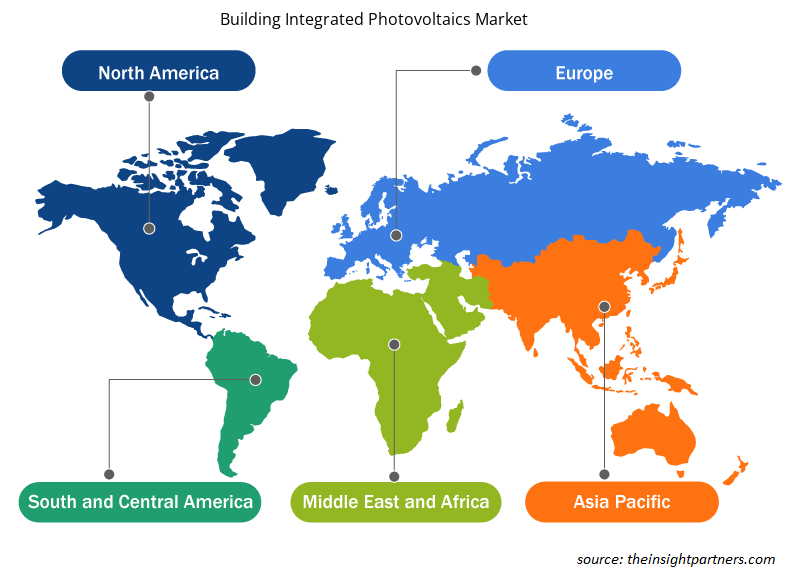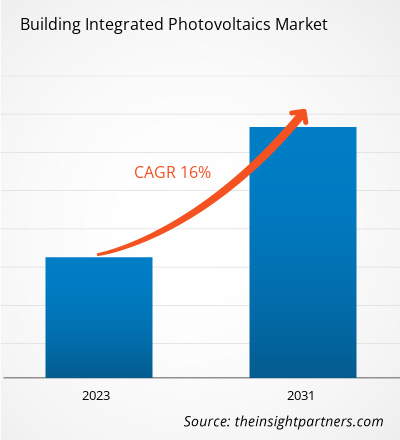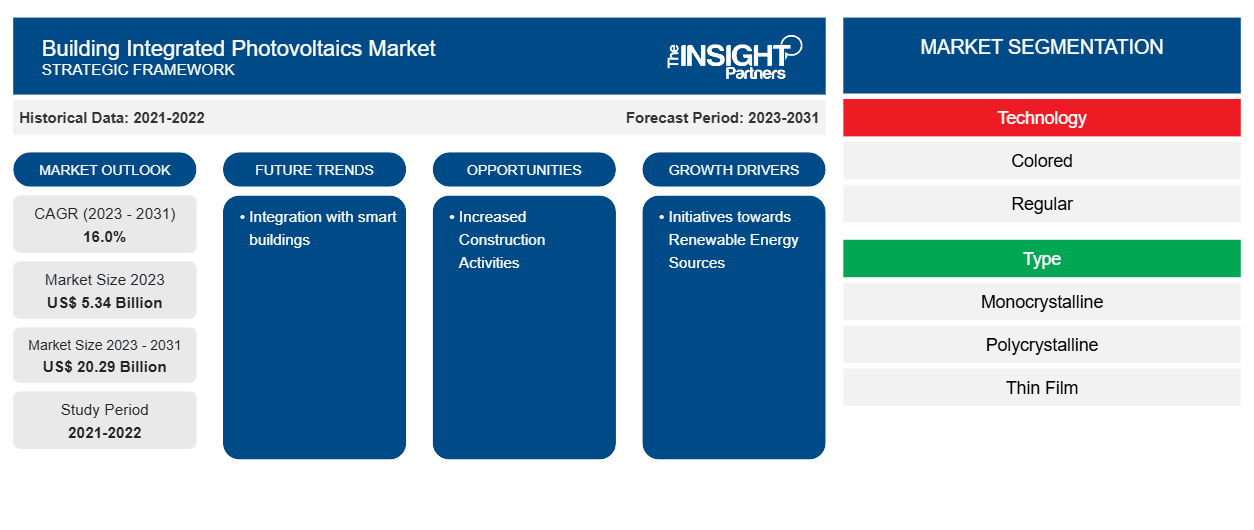建筑一体化光伏市场规模预计将从 2023 年的 53.4 亿美元增至 2031 年的 202.9 亿美元。预计 2023-2031 年期间该市场的复合年增长率将达到 16.0%。与智能建筑的融合可能仍是市场的主要趋势。
建筑一体化光伏市场分析
可再生能源需求的不断增长,加上交通电气化以及石油和天然气公司在电力价值链中的参与度不断提高,正在加速终端行业的融合。
建筑一体化光伏市场概况
建筑一体化光伏 (BIPV) 是一种太阳能发电产品或系统,可无缝集成到建筑围护结构中,并充当外墙、屋顶和窗户等建筑组件。建筑一体化光伏 (BIPV) 系统将太阳能转化为电能,同时还提供防风雨、隔热、降噪、日光照明和安全。BIPV 系统可以在建筑物施工阶段安装,也可以在现有建筑物的改造过程中部署,当需要更换外部组件之一时。建筑环境提供了各种 BIPV 集成选项。
定制此报告以满足您的需求
您可以免费定制任何报告,包括本报告的部分内容、国家级分析、Excel 数据包,以及为初创企业和大学提供优惠和折扣
-
获取此报告的关键市场趋势。这个免费样品将包括数据分析,从市场趋势到估计和预测。
建筑一体化光伏市场驱动因素和机遇
可再生能源举措有利于市场
全球建筑一体化光伏市场正受到推广可再生能源的努力的推动。例如,拜登政府打算在 2035 年前逐步淘汰化石燃料作为美国的能源来源。白宫宣布了到 2030 年实现 80% 可再生能源发电、五年后实现 100% 无碳发电的目标。建筑一体化光伏通过取代屋顶、天窗和外墙等传统建筑元素来产生太阳能电力。对可再生能源和可持续性的日益重视正在促进 BIPV 行业的扩张。
建筑活动增加
建筑活动的增加,尤其是在新兴国家,正在推动建筑一体化光伏 (BIPV) 行业的发展。快速的城市化和新建筑的建设为 BIPV 系统的实施带来了前景。对新建筑的需求不断增长,推动了 BIPV 行业的扩张。美国建筑师协会估计,2024 年建筑业投资总体将增长 6%,其中商业投资增长 3%,工业投资增长 15%,机构建筑投资增长 4%。
建筑一体化光伏市场报告细分分析
有助于得出建筑一体化光伏市场分析的关键部分是技术、类型、应用和最终用途。
- 根据技术,市场分为彩色和普通两种。彩色部分在 2023 年占据了相当大的市场份额。
- 根据类型,市场分为单晶硅、多晶硅和薄膜硅。2023 年,单晶硅占据了更大的市场份额。
- 根据应用,市场分为屋顶、墙壁、玻璃、外墙等。屋顶部分在 2023 年占据了更大的市场份额。
- 根据最终用途,市场分为工业、商业和住宅。住宅市场在 2023 年占据了最大的市场份额。
建筑一体化光伏市场份额按地区分析
建筑一体化光伏市场报告的地理范围主要分为五个区域:北美、亚太、欧洲、中东和非洲、南美和中美。
北美国家建筑业的增长,加上商业空间的增加,是推动该地区建筑一体化光伏市场增长的关键因素。将太阳能发电设备直接集成到建筑区域可以提高材料效率并降低产品成本。此外,人们越来越意识到需要提高建筑物的能源效率,这促进了清洁或可再生能源技术的使用。北美在提高能源效率方面的举措和行动计划有所增加。例如,加拿大政府致力于借助其低碳经济基金和其他基础设施计划提高住宅和建筑的能源效率。2021 年 5 月,政府启动了加拿大绿色家园计划,以升级住宅、建筑和商业综合体,提高其能源效率。根据美国能源效率经济委员会的研究,到 2050 年,能源效率的提高可以使美国的能源使用量和温室气体排放量减少一半。因此,这些因素正在促进市场的增长。
建筑一体化光伏市场区域洞察
Insight Partners 的分析师已详细解释了预测期内影响建筑一体化光伏市场的区域趋势和因素。本节还讨论了北美、欧洲、亚太地区、中东和非洲以及南美和中美洲的建筑一体化光伏市场细分和地理位置。

- 获取建筑一体化光伏市场的区域特定数据
建筑一体化光伏市场报告范围
| 报告属性 | 细节 |
|---|---|
| 2023 年的市场规模 | 53.4 亿美元 |
| 2031 年市场规模 | 202.9亿美元 |
| 全球复合年增长率(2023 - 2031) | 16.0% |
| 史料 | 2021-2022 |
| 预测期 | 2023-2031 |
| 涵盖的领域 |
按技术分类
|
| 覆盖地区和国家 |
北美
|
| 市场领导者和主要公司简介 |
|
市场参与者密度:了解其对商业动态的影响
建筑一体化光伏市场正在快速增长,这得益于终端用户需求的不断增长,而这些需求又源于消费者偏好的不断变化、技术进步以及对产品优势的认识不断提高等因素。随着需求的增加,企业正在扩大其产品范围,进行创新以满足消费者的需求,并利用新兴趋势,从而进一步推动市场增长。
市场参与者密度是指在特定市场或行业内运营的企业或公司的分布情况。它表明在给定市场空间中,相对于其规模或总市场价值,有多少竞争对手(市场参与者)存在。
在建筑一体化光伏市场运营的主要公司有:
- 赫利埃泰克
- AGC公司
- 埃泰克斯太阳能技术有限公司
- 索尔
- 大都会太阳能公司
- Onyx太阳能集团有限公司
免责声明:上面列出的公司没有按照任何特定顺序排列。

- 了解建筑一体化光伏市场顶级关键参与者概况
建筑一体化光伏市场新闻和最新发展
建筑一体化光伏市场通过收集一手和二手研究后的定性和定量数据进行评估,其中包括重要的公司出版物、协会数据和数据库。建筑一体化光伏市场的一些发展情况如下:
- Onyx Renewable Partners, LP(Onyx)和 Sol Systems LLC(Sol)宣布达成协议,购买和出售 24 兆瓦(MWdc)太阳能和储能开发组合,该组合将为五个州的企业和社区提供清洁、可靠的电力。Sol 发起并开发了该组合的八个分布式发电 (DG) 太阳能和储能项目,并通过持续积极参与客户和项目协调活动,继续致力于服务客户。(来源:Onyx Renewable Partners, LP,新闻稿,2024 年 2 月)
- 有机光伏领域的全球领导者 Heliatek 和液体防水专家 Triflex 宣布建立独家合作伙伴关系,为最可持续、最高效的屋顶翻新提供完整的系统解决方案。结合 Heliatek 的 HeliaSol 太阳能薄膜和 Triflex 液体应用防水材料,客户将受益于联合测试的解决方案,以安全密封屋顶,延长其使用寿命,同时产生清洁太阳能。(来源:Heliatek,新闻稿,2023 年 11 月)
建筑一体化光伏市场报告范围和交付成果
“建筑一体化光伏市场规模和预测(2021-2031 年)”报告对以下领域进行了详细的市场分析:
- 建筑一体化光伏市场规模及全球、区域和国家层面所有关键细分市场的预测
- 建筑一体化光伏市场趋势以及市场动态,如驱动因素、限制因素和关键机遇
- 详细的 PEST/波特五力分析和 SWOT 分析
- 建筑一体化光伏市场分析涵盖关键市场趋势、全球和区域框架、主要参与者、法规和最新市场发展
- 行业格局和竞争分析,涵盖市场集中度、热图分析、知名参与者以及建筑一体化光伏市场的最新发展
- 详细的公司简介
- 历史分析(2 年)、基准年、预测(7 年)及复合年增长率
- PEST和SWOT分析
- 市场规模、价值/数量 - 全球、区域、国家
- 行业和竞争格局
- Excel 数据集
近期报告
客户评价
购买理由
- 明智的决策
- 了解市场动态
- 竞争分析
- 客户洞察
- 市场预测
- 风险规避
- 战略规划
- 投资论证
- 识别新兴市场
- 优化营销策略
- 提升运营效率
- 顺应监管趋势























 获取免费样品 - 建筑一体化光伏市场
获取免费样品 - 建筑一体化光伏市场